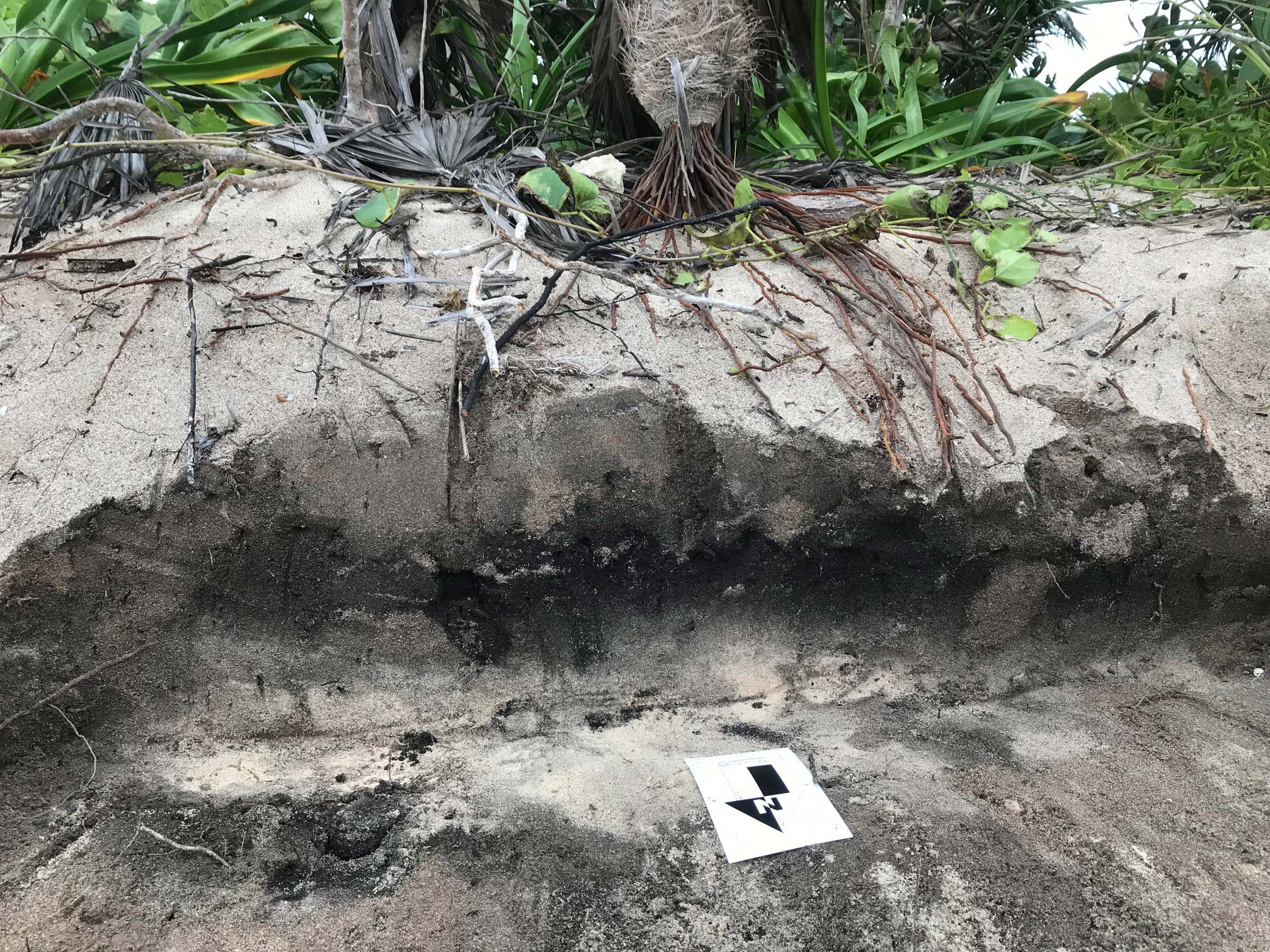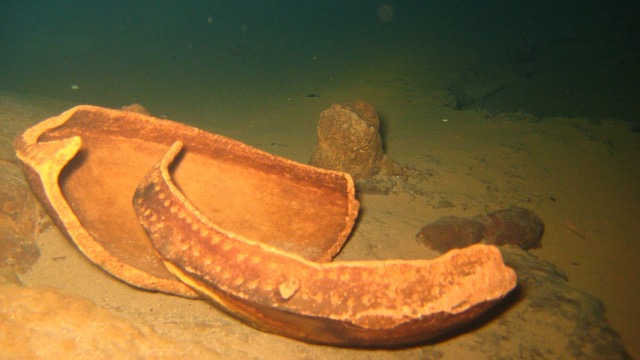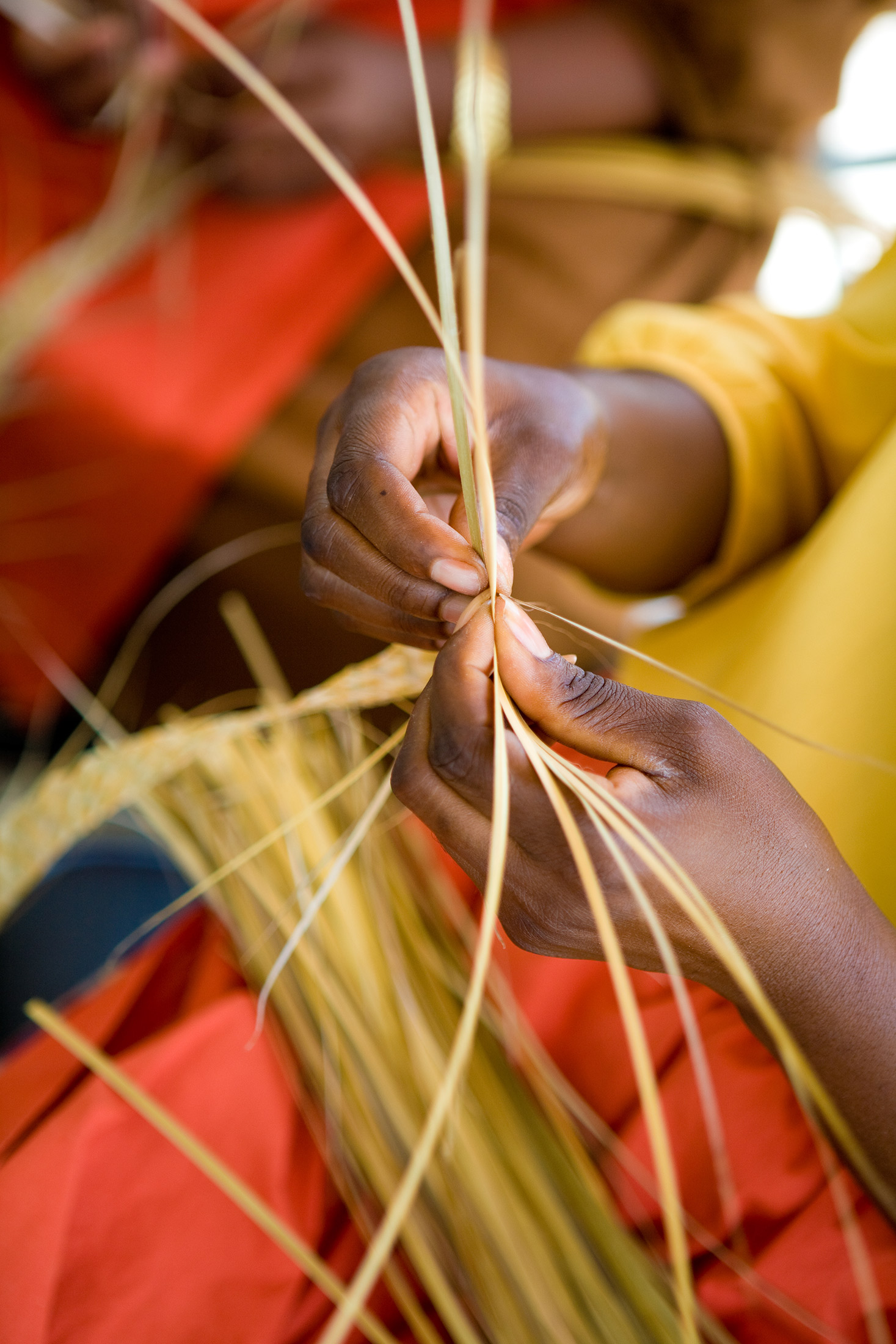Irving Rouse, the doyen of Caribbean archaeology, once estimated that pottery comprised 90% of all artifacts found in the region. It should come as no surprise then that the precontact history of the islands is written as if broken pieces of pottery (called sherds[1]) – not people – were the main actors. Pottery vessels, like the one recovered underwater from a TCI cave (pictured), still contain a wealth of information. And though potsherds may be the most abundant product of human manufacture, far greater quantities of things that people used are preserved in archaeological sites.
People were living in the Caribbean for about 5,000 thousand years before pottery became widely available. So how did they cook their meals? Unfortunately, we don’t really know the answer because food preparation has not been investigated for these first inhabitants. After pottery came to dominate archaeological assemblages, we tended to assume that its superior qualities as cooking vessels made other cooking techniques unnecessary. We have recently learned that clay pots did not completely replace other cooking methods. Because the Lucayan Islands were settled last, and their settlements moved frequently, preparing meals without having to carry heavy and fragile clay pots facilitated the exploration of new islands and the short-term exploitation of resources away from settlements.
Even today, different meals require different cooking methods. Some foods are roasted, broiled or grilled and others baked, boiled, blanched or even eaten “raw” (like ceviche – cooked with lime juice). Pottery vessels are best suited for slow cooking stews. Diversity in cooking methods can be seen archaeologically as grilling, stone boiling, earth ovens and the use of sea turtle shells and baskets. Let’s look at the evidence.
The most widely recognized technique is the use of a green-wood lattice raised above a fire to grill meats. In fact, our word barbecue comes from the Taíno word barbacoa. When Columbus went ashore at Guantanamo Bay, Cuba, he observed an untended barbecue on which fish and iguana were roasting. His men helped themselves to the fish; but they left the iguana, whose appearance they found too disgusting-looking to eat. Grilling on an open flame or roasting in the hot coals have passed the test of time and remain popular, practically a national pastime, today. But not all foods lend themselves to cooking directly on the heat source, especially liquids.
Several aboriginal cooking methods involve the use of “hot rocks,” with these distinguished by differences in the types of rocks used and their placement in relation to the heating source. Hearths are an example of rocks arranged in a pit below the fire. When the fire burns down to coals, the stones lining the hearth radiate heat and facilitate cooking on the coals. At the Coralie site (GT-3) on Grand Turk, we found hearths constructed from limestone and conch shells on which the shell (carapace) of a sea turtle was used as a cooking vessel. Some of the turtle bones were still in place on top of hearths, and they showed charring from having been burned on one side. GT-3 is the only site in all of the Caribbean where this cooking method has been reported.

Photo courtesy of Bill Keegan
A second type of hot rock cooking involves the placement of stones on top of the coals. Called “earth ovens,” they may be the most common form of baking found around the world. These ovens are comprised of seven parts: prepared basin, fire, layer of hot rocks, lower packing layer, food, upper packing layer (composed of green vegetation, the packing layers protect the food from contaminants) and an earthen cap. Some will recognize this description as a New England clambake or southern pig roast. Earth ovens are reported for “preceramic” (Archaic Age sites) but their first discovery in a context where people made ample use of pottery vessels occurred recently on Long Island (the Bahamas).
The Long Island ovens were found at three sites on top of sand dunes along the Atlantic coast. The sites appear to have been of short duration, perhaps fishing camps or seasonal farmsteads, where it was inconvenient to carry heavy and fragile cooking pots from the settlement. Indeed, very little pottery has been found at any of these sites. These pit features are about three-feet in diameter and about two-feet deep. The rocks are clearly positioned on top of the dark earth and charcoal from the fire that was built in the pit first. Fish bones, lobster and clam shells found at the sites suggest ancient clambakes. In order to determine what vegetable foods may have been cooked in these ovens, we sent several shell and stone tools for starch grain analysis. Over the past decade, archaeologists have refined techniques for extracting the starch grains from plants from a variety of tools. Every plant has its own unique grain shape, much like pollen (or fingerprints). The analysis identified corn, manioc and zamia on clamshell scrapers and a limestone grater board chip.
We can’t let mention of zamia pass without taking a brief side trip. Zamia, also known as coontie, is a tropical cycad that is native to the Lucayan Islands and grows along the Atlantic dunes. In a strange twist of botanical trickery, it is the stem that develops into a thick tuber-like growth below ground. Zamia was an important food source in the precontact Caribbean, especially in the arid eastern Dominican Republic. Like bitter varieties of manioc, zamia contains toxins and cannot be eaten raw. It is processed in a manner very similar to making cassava bread. The stem is grated on a wooden board into which small sharp pieces of stone have been set. Liquid is squeezed from the pulp, and then balls of the mash are set in a cool dry place to ferment. While fermenting, the balls become infested with beetle larvae. The balls are then flattened and baked, larvae and all (extra protein)!

Photo courtesy of Mark Parrish
The discovery of earth ovens on Long Island led us to reconsider the archaeological evidence at the Governor’s Beach site (GT-2) on Grand Turk. GT-2 reflects seasonal visits to Grand Turk from Haiti that are dated to the end of the 13th century. The main activity was the manufacture of shell disc beads from the cherry jewel box shell (Chama sarda). The shallow deposits indicate that these were temporary visits. The site contained very small quantities of pottery sherds, including several sherds from small effigy bowls brought from Hispaniola. The pottery at the site was inadequate for cooking meals. Instead, the main deposit was a dense layer of fire-cracked limestone with interspersed circular compact-sand features of about 10 inches in diameter. The features formed a compact surface about three cm thick that produced a ringing sound when struck with a trowel and were clearly different from the surrounding sand matrix. X-ray diffraction analysis identified these hard-packed features as a form of cement. The original thought was that they were constructed for use as bead-polishing surfaces. However, none of these features exhibited any evidence of use-wear from polishing beads; most were surrounded by large quantities of fire-cracked limestone, and their arrangement appears too haphazard to facilitate simultaneous use as polishing stations. It now seems likely that these are places where baskets, or other porous containers, were set in an earth oven.
The hot rocks often are rearranged prior to the addition of plant materials and foodstuffs. We propose that spaces were cleared among the rocks for the placement of baskets containing mollusks and that they left their mark as circular features caused by “clam juice” (liquid calcium carbonate and minerals) mixing with the sand to create a cement-like pad.
Cooking in baskets would allow for a substantial number of small mollusks and crustaceans to be heated at one time without them being scattered in the fire. For example, Tiger Lucine clams (Codakia orbicularis) are very common in Lucayan sites, and a 10-inch wide by five-inch tall basket could hold about 100 clams. Similarly, nerites are marble-size snails that occur in large numbers along rocky shorelines. In archaeological sites, the lip (with its “bleeding tooth”) is usually separated from the rest of the shell. We found that striking the fresh snail on a hard surface, like cracking a nut, produces a mass of flesh and smashed shell. But when the snails were parboiled for a few minutes, the lip easily separated with a light tap.

Photo courtesy of Sara Kaufman
We know that the Lucayans made basketry because their impressions are found on pottery vessels. The majority of basket impressions are observed on flat clay griddles as if the clay was pressed out on a clean, dry mat. However, basket impressions are also found on hemispherical bowls. A diversity of weaving styles has been identified which may represent the work of particular individuals, in other words, leaving something akin to a maker’s mark. In addition, the Spanish chronicler Bartolomé de las Casas reported seeing Indigenous water-tight baskets in Cuba in the early 1500s.
Water-tight baskets opened a new line of investigation. Prior to the adoption of pottery vessels, “stone boiling” was among the most common preparation methods for cooking food in a liquid. It involves the transfer of rocks heated in the coals of a fire to an impermeable container of liquid and food items. The red-hot rocks substantially raise the temperature of the contents, but not to the boiling point of water. The process is more similar to near-boiling or rapid steaming, although when hot rocks are added to the liquid the water does appear to boil.
Boiling cobbles typically are spheroid shapes measuring four to six inches. They are smooth-surfaced, hard, resistant to thermal stress and minimally soluble. Stone boiling experiments show that a significant percentage of the rocks crack and fracture during the cooking process, especially when heated multiple times. Different types of rock fracture at different rates and in different ways, sometimes in the fire, but more often from the thermal shock that occurs when they are dropped into a cool liquid.
There are no typical boiling stones available in The Lucayan Islands because they are composed entirely of soft and soluble limestone. In contrast, coral cobbles of appropriate sizes are readily available and easily collected along Atlantic Coast beaches. And we find lots and lots of burned coral at Lucayan sites, despite no ready explanation for why corals were being burned. With this in mind we conducted a series of experiments. Coral cobbles were collected from a beach, heated in an open fire and transferred with tongs into a container of water. The cobbles quickly raised the temperature of the water to just below the boiling point. Success! But best of all, the cobble were discolored and fractured into shapes that match those observed in archaeological deposits. Although our experiments do not prove that the Lucayans used “coral boiling” to cook particular foods, our results are consistent with the archaeological evidence.
It is perhaps unfortunate that archaeologists often describe ancient foodways as subsistence, as if people only eat from necessity. The modern diversity of regional “cuisines” highlights the rich cultural heritage of cooking found around the world. There is no reason to assume that the Lucayans were any less creative when it came to cooking and eating. Moreover, we tend to assume that when something new comes along it will replace what came before. The evidence of traditional methods of food preparation we now see in the Lucayan Islands offers a window into Indigenous Caribbean cooking before and after pots. Even with a pot to cook in, some foods are better prepared without.
Bill Keegan is curator of Caribbean Archaeology at the Florida Museum of Natural History (University of Florida); Betsy Carlson is senior archaeologist at Southeastern Archaeological Research (SEARCH, Inc.) in Jonesville, FL; Michael Pateman is former director of the Turks and Caicos National Museum and currently curator/lab director of the AEX Maritime Museum on Grand Bahama; and Lindsay Bloch is collections manager of the Ceramic Technology Laboratory, Florida Museum of Natural History (University of Florida).
[1] Lexical note – sherd versus shard: sherd refers only to broken pieces of pottery, while shard may be used for any broken bits of glass, metal, rock and pottery.
Editor’s note: This article first appeared in “Times of the Islands.”
Writers: Bill Keegan, keegan@flmnh.ufl.edu;
Betsy Carlson, betsy@searchinc.com;
Michael Pateman, mpateman@ammcbahamas.com;
Lindsay Bloch, lbloch@floridamuseum.ufl.edu